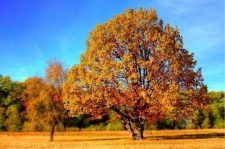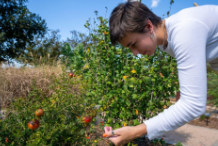UPCOMING EVENTS
K-State’s Turf and Ornamental Field Day is happening! It will be held at the Rocky Ford Turfgrass Research Center, 1700 Barnes Road, on Thursday, August 5. Due to the pandemic (which is receding for now!), we will have a change of structure for our tour of research plots and conversations with faculty and graduate students. Please note that the format and guidelines are subject to further change or cancellation, based on KSU and state/local health policies.
For a copy of the program and exhibitor information, go to http://www.kansasturfgrassfoundation.com/
You can register online at https://2021turfday.eventbrite.com
Online advanced registration is strongly recommended.
Parking at Faith E Free Church – 1921 Barnes Road, Manhattan, KS.
- There will be no formal welcoming session this year.
- Tours will leave from the registration area about every 15 minutes beginning at 8:30 a.m. and running until 10 a.m.
- You can arrive anytime between about 8:15 am (or earlier) and 9:45 am to join one of the tours.
- 8 stops with different presenters, each running about 15 minutes.
No donuts or coffee will be provided, but a boxed lunch will be available when your plot tour finishes. Take your boxed lunch and find your own space to eat – there will be some chairs spaced out in shaded areas. Or, feel free to take it “to go.”
Vendors will be present from 8 a.m. until about 1 p.m.
REMINDERS
• Sidedress tomatoes when they are full size but still green. Do not overfertilize tomatoes as this will prevent them from producing fruit. https://tinyurl.com/y7d5ns2z
Core aerate zoysia to prevent thatch buildup and aerate soil.
VEGETABLES
Pulling Onions
Onions are ready to harvest when about half the plants have tops that have fallen over. This is a sign that the onions are mature and need to be pulled out of the ground. Bulbs may sunburn without the foliage to protect them. The secret to onions keeping well is to allow the tops to dry completely before storage. This may take 2 to 3 weeks. Large-necked onions take more time to dry than small-necked onions such as Bermuda types. Move onions to a shaded, well-ventilated area after harvest and spread them out.
After tops are completely dry, remove the dry foliage and compost. Store the bulbs in a cool, dry location. Avoid storage in plastic bags because the lack of air circulation will shorten storage life. Use an open, mesh bag instead. (Ward Upham)
Squash Vine Borer
If you have squash or related plants that suddenly wilt and die, you may have squash vine borer. This insect will bore into the stems of squash, zucchini, pumpkins and gourds.
Zucchini squash are a favorite. Cucumbers and melons are usually not a target, although both can be affected by a disease that causes similar symptoms, known as bacterial wilt.
The adult of this insect is a clear-winged moth that resembles a wasp. The forewings are a dark metallic green but the rear wings are clear. The abdomen is orange with black spots.
The larva is cream-colored and rather wrinkled. Adults emerge in the spring and lay eggs on or near susceptible plants. Eggs are deposited singly on the underside of the vines and are often concentrated at the base of the plants. Larva bore into the plant and feed for about a month as they move toward the base. Mature larva will exit the plant, burrow into the soil and pupate where they remain until the next year. Each plant can have numerous borers. If you suspect squash vine borer, split the stem of a collapsed plant near where it enters the ground. Infested plants will be hollowed out and mushy and may contain borers.
Unfortunately, there isn’t much you can do at this late stage. Control measures should center on prevention.
Suggested preventative controls would include crushing the dull red eggs before they hatch, excavating larvae from stems before they cause much damage or using insecticide applications. Applications should begin when the vines begin to run (too late for that) and reapplied every seven to 10 days through the end of June. Direct the spray at the crown of the plant and the base of runners. Chemicals used for borer control in gardens are permethrin (Eight Vegetable, Fruit & Flower Concentrate; Lawn, Garden, Pet and Livestock Insect Control; Lawn & Garden Insect Killer) or bifenthrin (Hi-Yield Bug Blaster II, Bug-B-Gon Insect Killer for Lawns & Gardens) applied as sprays or dusts. If plants wilt, look for the presence of holes and ooze. However, in extreme heat, these plants will temporarily wilt in the afternoon even if undamaged by this insect. (Ward Upham)
Raccoons and Sweet Corn
It seems the official sweet corn inspector should be the raccoon as they seem to harvest the sweet corn the day before it is to be picked. The only effective control measure I have had success with is fencing; either electric or kennel fencing. First are some suggestions for electric fencing. Other designs may very well work but this is what has worked in my garden.
– Two or more wires must be used. Place the first about 5 inches above the ground and the second 4 inches above the first (or 9 inches above ground). Raccoons must not be able to crawl under, go between or go over the wires without being shocked.
– Fence posts used for electric fences work well for this application (go figure), as do the insulators used to support the electric wire.
– It is much easier to use the woven electric wire with strands of wire embedded than to use a solid metal wire. The woven wire is easier to bend around corners and to roll up when done for the year.
– Though both the plug-in and battery operated fencers work, the battery operated types allow more versatility in where corn is grown. One set of batteries is usually sufficient for the season.
– Start the charger before the corn is close to being ripe. Once raccoons get a taste of the corn, they are more difficult to discourage.
– Control weeds near the wire. Weeds can intercept the voltage if they touch a wire and allow raccoons entry beyond the weed.
– Check the wire occasionally to make sure you have current. This can be done easily (but unpleasantly) by touching the wire. There are also tools that will measure the voltage available for sale. They are worth the money.
As mentioned earlier, kennel fencing can also be used. Make sure that the panels are tied together well enough that raccoons can’t squeeze through corners. A covering over the top may be needed if the raccoons figure out how to climb the panels. Welded garden fence can work well for this. (Ward Upham)
Sweet Corn Earworm
Corn earworm tends to be a problem every year on sweet corn in Kansas. The earworm moth lays eggs on developing silks at night. When the egg hatches, the larva crawls down the silk and into the ear. Feeding starts at the tip of the ear and works down. Though several earworms may hatch and attack a single ear, only one is usually present at harvest due to the cannibalistic nature of the insect. Control is challenging as silks continue to grow over a period of time. This means that even if silks are treated, new silk will appear that hasn’t been protected. Applications every 2 to 3 days are needed for insecticides to be effective, especially in early July when peak flight of these moths usually appear.
There is a three-week period from silking to harvest, but there is only a two-week period from when the silks appear to when they begin to dry. Since moths prefer juicy silks and shun those that have started to dry, insecticides are only needed the first two weeks of silking.
Homeowners can use cyfluthrin (Baythroid; BioAdvanced Vegetable and Garden Insect Killer) or spinosad (Captain Jack’s Dead Bug Brew; Natural Guard Spinosad, Monterey Garden Insect Spray). Spinosad is an organic product. Commercial growers have additional choices including zeta-cypermethrin (Mustang Max), bifenthrin+zeta-cypermethrin (Hero), spinetoram (Radiant) and flubendiamide (Belt).
Though more time consuming, mineral or other light horticultural oils may also be used as an organic control. The oil is placed inside the silk end of the ear with a medicine dropper (½ to 3/4 of a dropper) when the tips of the silks begin to wilt and turn brown. This will coat the earworms already present and likely suffocate them and earworms that enter the ear after the mineral oil is applied will also be controlled. Applying the oil before the silk has begun to brown may interfere with pollination, leading to incompletely filled ears. (Ward Upham)
Why Tomatoes Don’t Set Fruit During Hot Weather
Tomatoes will not produce fruit when the temperature rises above a certain point. Though there is some variation, a temperature of 95 degrees or above will stop fertilization and therefore fruit production. Fruit that has already formed is not affected.
So how does this work? For fertilization to take place, a pollen grain must land on the stigma of the flower. A pollen tube is then formed which grows from the stigma, down through the style to the ovule where fertilization take place. Excessive heat literally causes the pollen tube to explode, thereby preventing pollination. Even short bursts of temperatures above 95 degrees are enough to cause this reaction. Once temperatures cool, pollination can again take place.
I mentioned before that there is some variation among varieties in how susceptible they are to heat preventing fruit formation. There are “heat-set” slicing tomatoes such as Florida 91, Sun Leaper and Sun Master that will set fruit at higher temperatures, but that difference is normally only 2 to 3 degrees. (Ward Upham)
FRUIT
When to Pick Blackberries
The exact time to harvest blackberries varies by cultivar, with thorny blackberries normally ripening earlier than thornless types. But there are some general guidelines to keep in mind when harvesting blackberries. Do not pick blackberries too early or berry size and flavor will be sacrificed.
Two major characteristics determining maturity for harvest are fruit color and ease of separation. Blackberries usually develop a dull, black color with plump, juicy fruitlets as they ripen. The berries soften and produce the characteristic blackberry flavor. Full color often develops before the berries separate easily. Pick the berries by gently lifting with the thumb and fingers. The receptacle, or center part of the fruit, remains in the fruit when blackberries are harvested, unlike raspberries, which leave the receptacle on the bush. Take care not to crush the berries or expose them to the hot sun.
When possible, avoid picking berries when they are wet. They’ll likely need picking every second or third day. Cool the berries immediately after harvest to extend shelf life. Keep them refrigerated under high relative humidity and use within three to five days. (Ward Upham)
PESTS
Aphids on Daylilies
Daylilies with browning foliage should be checked for aphids. If aphids are present, look for ladybugs. The presence of ladybugs means there is no need to try to control the aphids. The ladybugs will do that for you.
However, if there are no ladybugs, control measures may be called for. A strong jet of water from a garden hose may be all that is needed. Repeat as necessary. If this is not possible, insecticides can be used such as horticultural oil, insecticidal soap, acephate (Acephate, Orthene), malathion, cyfluthrin (Baythroid, BioAdvanced Vegetable and Garden Insect Spray) or permethrin (38 Plus Turf, Termite & Ornamental Insect Spray; Eight Vegetable, Fruit & Flower Concentrate; Garden and Farm Insect Control). Reapplication may be needed. (Ward Upham)
TREES
Dutch Elm Disease (DED)
People often assume that all of our American Elms have been killed by Dutch elm disease. Fortunately, such is not the case. Though many have survived thus far, the number diminishes each year. We are still seeing examples of Dutch elm disease on American elms. Though American elms are the species often associated with this disease, red and some hybrid elms are also susceptible. Siberian elm (sometimes referred to as Chinese elm) and the true Chinese elm (Lacebark elm) are considered resistant but not immune to the disease. However, we do have true American Elms that are naturally resistant. Our January 19 issue of this newsletter has an article on these cultivars. That issue can be found at: https://www.ksuhortnewsletter.org/newsletters/dutch-elm-disease-resistant-american-elms1935833
Early diagnosis can help save recently infected trees. Look for branches with leaves that have wilted and suddenly turned yellow to brown. Remove a portion of the branch and peel back an area of the bark. If you notice brown streaking in the sapwood, you may have Dutch elm disease. Healthy bark is more cream-colored and the streaking is absent. Suspect wood should be submitted to the diagnostic lab and control measures started immediately.
Dutch elm disease can often be controlled through the use of systemic fungicide injections, judicious pruning of affected trees and removal of nearby diseased elms. However, trees infected through root grafts with nearby infected elms or those in which the disease has reached the main stem cannot be saved. Therefore, preventative measures have a better chance of success and are preferred. Fungicides labeled for Dutch elm disease include Arbotect and Alamo. The Arbotect fungicide is preferred because it is the most persistent with a three-year interval between injections. Alamo may need to be applied every year in high risk areas with high value trees. A trained arborist should administer injections. These treatments are quite expensive. Check with your local arborist for current prices.
Megan Kennelly, one of our plant pathlogists, has a more detailed discussion of this disease in our Turf Blog. See http://blogs.k-state.edu/turf/dutch-elm-disease/ (Ward Upham)
Contributors: Ward Upham, Extension Associate
Division of Horticulture
1712 Claflin, 2021 Throckmorton
Manhattan, KS 66506
(785) 532-6173
For questions or further information, contact: [email protected] OR [email protected]
This newsletter is also available on the World Wide Web at: http://hnr.k-state.edu/extension/info-center/newsletters/index.html
The web version includes color images that illustrate subjects discussed. To subscribe to this newsletter electronically, send an e-mail message to [email protected] or [email protected] listing your e-mail address in the message.
Brand names appearing in this newsletter are for product identification purposes only. No endorsement is intended, nor is criticism implied of similar products not mentioned.
K-State Research and Extension is committed to making its services, activities and programs accessible to all participants. If you have special requirements due to a physical, vision or hearing disability, or a dietary restriction please contact Extension Horticulture at (785) 532-6173.
Kansas State University Agricultural Experiment Station and Cooperative Extension Service K-State Research and Extension is an equal opportunity employer. Issued in furtherance of Cooperative Extension Work, Acts of May 8 and June 30, 1914, as amended. Kansas State University, County Extension Councils, and United States Department of Agriculture
Cooperating, Ernie Minton, Dean.
https://hnr.k-state.edu/extension/info-center/newsletters/index.html
Blog Post: http://www.ksuhortnewsletter.org
Video of the Week: Harvesting and Storing Onions
https://kansashealthyyards.org/all-videos/video/harvesting-and-storing-onions





